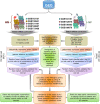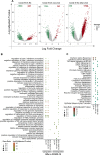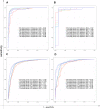Identifying novel host-based diagnostic biomarker panels for COVID-19: a whole-blood/nasopharyngeal transcriptome meta-analysis
- PMID: 35922752
- PMCID: PMC9347150
- DOI: 10.1186/s10020-022-00513-5
Identifying novel host-based diagnostic biomarker panels for COVID-19: a whole-blood/nasopharyngeal transcriptome meta-analysis
Abstract
Background: Regardless of improvements in controlling the COVID-19 pandemic, the lack of comprehensive insight into SARS-COV-2 pathogenesis is still a sophisticated challenge. In order to deal with this challenge, we utilized advanced bioinformatics and machine learning algorithms to reveal more characteristics of SARS-COV-2 pathogenesis and introduce novel host response-based diagnostic biomarker panels.
Methods: In the present study, eight published RNA-Seq datasets related to whole-blood (WB) and nasopharyngeal (NP) swab samples of patients with COVID-19, other viral and non-viral acute respiratory illnesses (ARIs), and healthy controls (HCs) were integrated. To define COVID-19 meta-signatures, Gene Ontology and pathway enrichment analyses were applied to compare COVID-19 with other similar diseases. Additionally, CIBERSORTx was executed in WB samples to detect the immune cell landscape. Furthermore, the optimum WB- and NP-based diagnostic biomarkers were identified via all the combinations of 3 to 9 selected features and the 2-phases machine learning (ML) method which implemented k-fold cross validation and independent test set validation.
Results: The host gene meta-signatures obtained for SARS-COV-2 infection were different in the WB and NP samples. The gene ontology and enrichment results of the WB dataset represented the enhancement in inflammatory host response, cell cycle, and interferon signature in COVID-19 patients. Furthermore, NP samples of COVID-19 in comparison with HC and non-viral ARIs showed the significant upregulation of genes associated with cytokine production and defense response to the virus. In contrast, these pathways in COVID-19 compared to other viral ARIs were strikingly attenuated. Notably, immune cell proportions of WB samples altered in COVID-19 versus HC. Moreover, the optimum WB- and NP-based diagnostic panels after two phases of ML-based validation included 6 and 8 markers with an accuracy of 97% and 88%, respectively.
Conclusions: Based on the distinct gene expression profiles of WB and NP, our results indicated that SARS-COV-2 function is body-site-specific, although according to the common signature in WB and NP COVID-19 samples versus controls, this virus also induces a global and systematic host response to some extent. We also introduced and validated WB- and NP-based diagnostic biomarkers using ML methods which can be applied as a complementary tool to diagnose the COVID-19 infection from non-COVID cases.
Keywords: Biomarker; COVID-19; Data integration; Nasopharyngeal swab; Pathogenesis; Random forest; SARS-COV-2; Systems biology; Whole blood.
© 2022. The Author(s).
Conflict of interest statement
The authors declare that they have no competing interests.
Figures







Similar articles
-
A diagnostic host response biosignature for COVID-19 from RNA profiling of nasal swabs and blood.Sci Adv. 2021 Feb 3;7(6):eabe5984. doi: 10.1126/sciadv.abe5984. Print 2021 Feb. Sci Adv. 2021. PMID: 33536218 Free PMC article.
-
Blood transcriptional biomarkers of acute viral infection for detection of pre-symptomatic SARS-CoV-2 infection: a nested, case-control diagnostic accuracy study.Lancet Microbe. 2021 Oct;2(10):e508-e517. doi: 10.1016/S2666-5247(21)00146-4. Epub 2021 Jul 6. Lancet Microbe. 2021. PMID: 34250515 Free PMC article.
-
Comparison of SARS-CoV-2 PCR-Based Detection Using Saliva or Nasopharyngeal Swab Specimens in Asymptomatic Populations.Microbiol Spectr. 2021 Sep 3;9(1):e0006221. doi: 10.1128/Spectrum.00062-21. Epub 2021 Aug 25. Microbiol Spectr. 2021. PMID: 34431689 Free PMC article.
-
Gene Expression Meta-Analysis Reveals Interferon-Induced Genes Associated With SARS Infection in Lungs.Front Immunol. 2021 Jul 23;12:694355. doi: 10.3389/fimmu.2021.694355. eCollection 2021. Front Immunol. 2021. PMID: 34367154 Free PMC article.
-
Performance of Non-nasopharyngeal Sample Types for Molecular Detection of SARS-CoV-2.Clin Lab Med. 2022 Jun;42(2):249-259. doi: 10.1016/j.cll.2022.02.002. Epub 2022 Feb 22. Clin Lab Med. 2022. PMID: 35636825 Free PMC article. Review.
Cited by
-
Review of Medical Studies on COVID-19 During the Pandemic Period.Eurasian J Med. 2022 Dec;54(Suppl1):154-158. doi: 10.5152/eurasianjmed.2022.22336. Eurasian J Med. 2022. PMID: 36655460 Free PMC article.
-
Identification of Key Genes Related to Immune Cells in Patients with COVID-19 Via Integrated Bioinformatics-Based Analysis.Biochem Genet. 2023 Dec;61(6):2650-2671. doi: 10.1007/s10528-023-10400-1. Epub 2023 May 24. Biochem Genet. 2023. PMID: 37222960 Free PMC article.
-
Long non-coding RNAs in biomarking COVID-19: a machine learning-based approach.Virol J. 2024 Jun 7;21(1):134. doi: 10.1186/s12985-024-02408-9. Virol J. 2024. PMID: 38849961 Free PMC article.
-
Humans with inherited MyD88 and IRAK-4 deficiencies are predisposed to hypoxemic COVID-19 pneumonia.J Exp Med. 2023 May 1;220(5):e20220170. doi: 10.1084/jem.20220170. Epub 2023 Mar 3. J Exp Med. 2023. PMID: 36880831 Free PMC article.
-
Transcriptome and machine learning analysis of the impact of COVID-19 on mitochondria and multiorgan damage.PLoS One. 2024 Jan 31;19(1):e0297664. doi: 10.1371/journal.pone.0297664. eCollection 2024. PLoS One. 2024. PMID: 38295140 Free PMC article.
References
Publication types
MeSH terms
Substances
LinkOut - more resources
Full Text Sources
Medical
Miscellaneous

